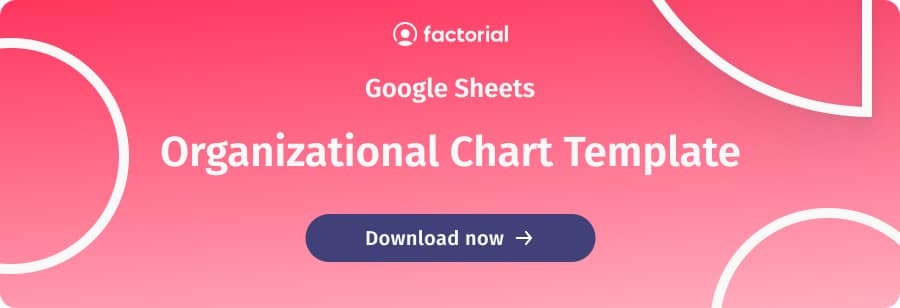Whether you are an established company or a new startup, a small business organizational chart can be a great way to demonstrate how your company operates. It can help your employees understand their roles and responsibilities within the hierarchy of the organization. It can also help clarify the chain of command within each department and the company as a whole.
However, it’s important to consider your goals and purpose before picking the right structure for your organization.
In this post, we will explain what a small business organizational structure chart is and what you need to consider before you create yours. We will also explain what the various types of charts are to help you find the right structure according to the needs of your company.
Small Business Organizational Chart: Definition
A small business organizational chart, also known as a small business organizational structure chart or an organigram, is a visual representation of the organizational structure of your company. It clearly outlines each department within your company and the roles and responsibilities of each employee. It serves as a visual prompt to highlight your reporting lines, and it can be a great way to show how you will grow as your company develops and expands. This can be especially useful if you are in the process of converting into an agile organization.
An organizational chart can have various structures and serve a variety of purposes. The type of organization chart you use will depend on the type of organization you have and what information you want to focus on conveying.
Before we go into more detail on this, let’s take a look at the benefits of creating an organizational chart in your company, and what you need to consider before you commit to a specific structure.
Why Should I Create an Organizational Chart?
Regardless of the nature of your company or how well-established you are, it’s important to make sure your organizational structure is clear and well-defined. According to McKinsey, it can help you better integrate your people, processes, and structures.
Org Chart benefits
A small business organizational chart:
- Defines the management structure of each department within your company.
- Clearly sets out the roles and responsibilities of each employee.
- Highlights your chain of command and reporting lines.
- Establishes how employees relate to each other.
- Supports effective internal communication.
- Facilitates the implementation and communication of all your company policies and procedures.
- Creates efficient and effective work process flows.
- Fosters team development.
- Increases operating efficiency.
- Facilitates planning and development.
How to Create an Organizational Chart for a Small Business
There are various types of organization charts to choose from. The format you pick will depend on a number of factors and will determine the information that you include in your chart.
The first step is to consider what your goals are for your small business organizational chart. You need to pick a structure that supports your internal operations, how work is undertaken, and your established chain of command. What work processes do you currently use? How many separate departments does your company have?
You then need to consider the size of your company. How many employees do you have? Are you departments large or small? What information do you want to include in your chart?
Once you’ve done this, you need to decide how you are going to create your chart. One option is to create your small business organizational chart using Microsoft Office (Excel, Outlook, PowerPoint, or Word) or Google Sheets. You can also use an org chart generator or template, as we will see shortly.
Finally, once you have completed your chart, you need to distribute it amongst all your employees. The best way to do this is by saving it on a shared company server or employee portal. This way all your employees have access to it at all times. And, more importantly, don’t forget to update it each time someone leaves or joins your company.
Types of Organization Charts: Advantages and Disadvantages
There are several distinct and commonly used types of organizational structures. The format you choose will depend on your individual business needs.
Let’s take a look at a few organizational chart examples with pros and cons to help you pick the right structure for your company.
Functional Organizational Chart
The first organizational chart example is the functional chart. You might pick this format if your company is large enough to divide employees into departments. This diagram shows the head of each department and all the employees that report to them. Functions are separated by expertise, and you have more lines of communication.
Advantage: establishes a clear hierarchy in each department while allowing for cross-communication.
Disadvantage: can create divisions between departments if a conflict develops or when different functional areas turn into silos that focus only on their area of responsibility.
Divisional Organizational Structure
This structure usually consists of a number of parallel teams focused on a single product or service line. Divisions are more autonomous and manage their own hiring, budgeting, and advertising. You could say it’s more of a decentralized version of the functional structure, as roles are separated by product or region.
Advantage: allows teams to focus on a single product or service, with a leadership structure that supports major strategic objectives. Also nurtures a common culture that contributes to higher morale.
Disadvantage: if clear strategies aren’t established, can lead to office politics. Can also result in compartmentalization and incompatibility.
Matrix Organizational Chart
Also known as a cross-functional business organizational chart, this structure allows for both horizontal and vertical reporting lines. This might be the choice for you if you have various departments working together on a new product line, or if your employees report to multiple managers.
Advantage: employees have responsibilities both within their department and for organizational projects, creating a more shared and collective knowledge-based model.
Disadvantage: unless clear communication practices are established, can be a challenge if employees are given direction from two different managers.
Horizontal Organizational Structure
This is more of a flat management structure and could be best for you if you have fewer managers with many employees. It’s also a good choice if you promote autonomy and your employees are able to make decisions without needing manager approval.
Advantage: providing your employees with autonomy can help them feel empowered and motivated. The relaxed structure of a horizontal organizational structure also encourages collaboration.
Disadvantage: lack of progression opportunities and increased workloads for managers as they are responsible for more employees.
Vertical Organizational Structure
The vertical organizational chart uses a pyramid-like top-down management structure. This could be the right structure for you if you have clearly defined roles in your organization with the highest level of leadership at the top, followed by middle management then regular employees.
Advantage: clear lines of authority, with quicker decision making and better designation of tasks to employees.
Disadvantage: has the potential to damage employee relations and lead to inefficiency if lower-level employees feel stifled.
Small Business Organizational Chart Template
One option for creating your small business organizational chart is using a template in Word or Excel. Both software choices have tools for creating and updating organizational charts, but features are limited and best suited for hierarchical organizations.
Organizational Chart Template Word
You can create a basic small business organizational chart template in Word using SmartArt. This is a good choice if you prefer words to numbers. Lines between boxes are automatically aligned, and you can quickly create subordinates and assistants for any position.
Organizational Chart Template Excel
You can also create an organizational chart template in Excel, also using the SmartArt feature. Just open a blank worksheet in Excel and click the Insert tab (or choose Insert from the drop-down menu). Click SmartArt, click Hierarchy, click Organization Chart.
Organizational Chart Maker for Small Businesses
If you don’t have the time, patience, or design skills to create your own organizational chart template in Excel or Word, then a simple solution is to use software or a pre-defined template.
For example, you can use Factorial’s HR software to generate your own small business organizational chart in seconds. All you have to do is invite your employees then the software automatically creates an organizational chart of your company. What’s more, every time someone joins or leaves your company, the chart will be automatically updated. Find out more about our all-in-one software solution here.
Finally, another alternative is to download Factorial’s Free Organizational Chart Templates for PowerPoint & Word. Both options help you better understand the structure of your company, improve communications, visually see gaps in the company, and more!
Just fill in the form to download the organizational chart template and we’ll send you an email with an org chart!



